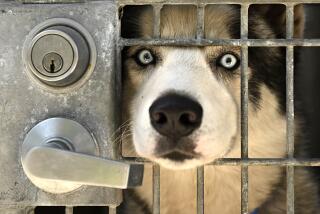A bad fit for Ballona Wetlands
It’s not surprising that the Annenberg Foundation’s plans for an expansive interpretive center in the Ballona Wetlands Ecological Reserve has stirred controversy. The cherished 640-acre reserve that stretches from Westchester to Marina del Rey has passionate advocates who often disagree on the best course for its restoration.
One element of the Annenberg plan that has come under fire is an animal adoption and care facility. That would be a welcome service in almost any other location in the Los Angeles area, but it doesn’t fit into a preservation scheme for Ballona and should not be part of a final design plan.
Certainly, this would be a very small part of Annenberg’s elaborate center and restoration efforts, to which the foundation is committing at least $50 million in a partnership with the California Department of Fish and Wildlife (which controls the wetlands), the state’s Coastal Conservancy and the Santa Monica Bay Restoration Commission. The animal adoption facility would take up about 1,500 square feet of the 46,000-square-foot interpretive center, as part of its educational narrative on the urban ecology of this area. “How do you leave cats and dogs out?” said Leonard Aube, executive director of the foundation.
The Annenberg Foundation has made no secret of its commitment to animal welfare, and it supports many organizations in that field. A few years ago, in partnership with the city of Rancho Palos Verdes, it tried to create a park at Lower Point Vicente with an interpretive center that also would have included a small animal adoption center. (That project ran into opposition too.) The foundation’s involvement in animal welfare concerns, particularly pet adoption, should be applauded. But a domestic animal adoption center, as well intentioned and needed as those kinds of facilities are, does not belong at Ballona.
Stewardship of this precious wetland is paramount, and the abuse of it — littering, dumping of soil from construction of Marina del Rey developments — has been shameful. And preservation means restoring the wetlands to a habitat for the flora and wildlife that have thrived there in the past and stubbornly remain despite urban encroachment: great blue herons, burrowing owls, voles and lizards, among other creatures. Yes, wandering feral cats are an intrusion these days, as are people illegally walking their dogs. Those issues need to be dealt with.
But the reason the state bought this land more than a decade ago was to preserve the last sizable coastal marsh in Los Angeles County. The goal should be to work hard to restore it, as well as offer visitors an educational experience about the urban wetland.
More to Read
A cure for the common opinion
Get thought-provoking perspectives with our weekly newsletter.
You may occasionally receive promotional content from the Los Angeles Times.






